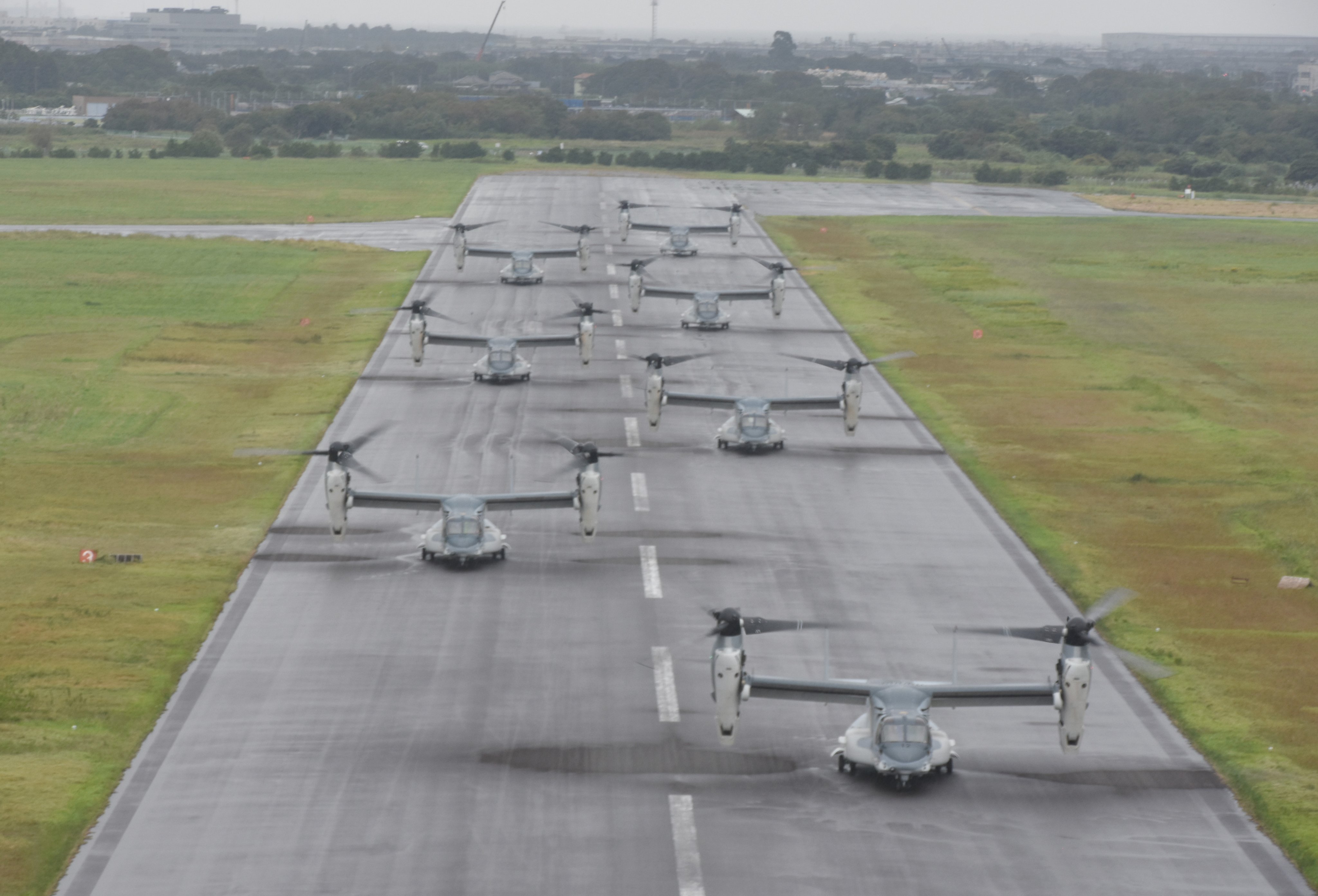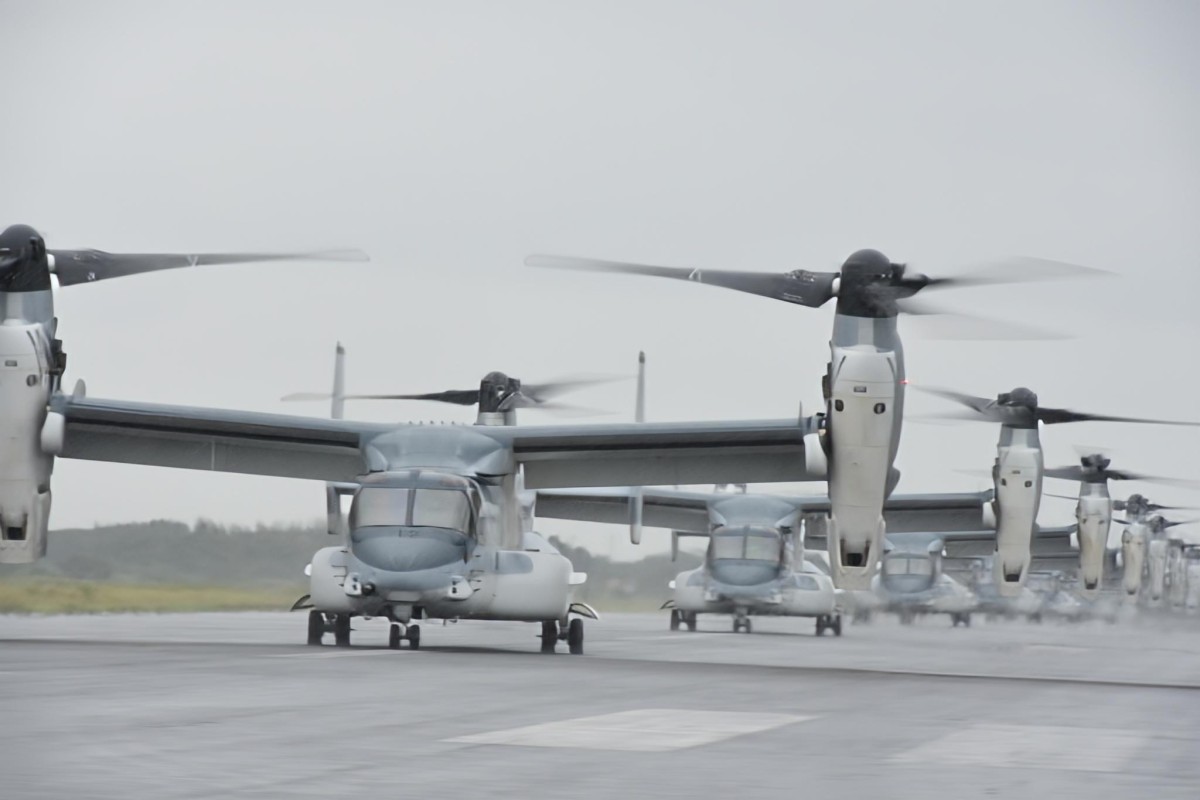The Japan Ground Self-Defense Force recently conducted an “Elephant Walk” featuring eight V-22 Osprey aircraft at the Kisarazu Air Show at Kisarazu Air Field.
“Elephant walk” refers to a military training exercise where multiple aircraft taxi together in a coordinated formation before taking off in rapid succession.
The event, held on October 5, was open to the public despite challenging weather conditions. The air show marks its 50th anniversary alongside the 56th anniversary of Kisarazu Air Base.
In a tweet posted on October 10, the 1st Helicopter Brigade’s Air Transport Corps thanked attendees, “Thank you for coming to the event despite the unfortunate weather!”
The notable feature of the show was the synchronized taxiing of eight V-22 Ospreys down the runway, a unique sight for the public.

The 1st Helicopter Brigade’s Air Transport Corps said, “Hello! This is the Air Transport Corps. On October 5th, the “50th Kisarazu Air Show – 56th Anniversary of Kisarazu Air Base” was held at Kisarazu Garrison and was open to the public. Eight V-22s performed the “Elephant Walk,” taxiing on the runway.”
The “Elephant Walk” maneuver is a crucial indicator of the fleet’s readiness and operational capability, effectively showcasing the strength and preparedness of the aircraft involved.
This demonstration takes on added significance in light of recent events, particularly following the tragic crash of a US Air Force Special Operations Command CV-22B on November 29, 2023, which resulted in the loss of eight service members. The incident prompted a safety standdown affecting approximately 400 Osprey aircraft.
Following this period of heightened caution, Tokyo resumed operations of the Ospreys in March. The Japan Ground Self-Defense Force (JGSDF) manages a fleet of 14 Ospreys, with three more ordered, to meet a total request of 17 aircraft. Japan is the only foreign operator of any variant within the V-22 tilt-rotor family.
The US military utilizes three distinct versions of the Osprey: the Marine Corps operates the MV-22, the US Navy employs the CMV-22B for carrier onboard delivery logistics, and the US Air Force uses the CV-22 for special operations.

V-22 Osprey Continues To Experience Crashes
The Bell-Boeing tiltrotor aircraft, known as the Osprey, has experienced a tumultuous history marked by numerous fatal crashes since its inaugural flight in 1989.
While it is considered a valuable asset in military operations, the Osprey has been surrounded by controversy because of funding issues, accidents, and tragic fatalities, leading to its unfortunate nickname, “the widow-maker.”
A significant incident occurred on November 29, 2023, when a CV-22B, designated as serial number 10-0054 and operating under the callsign Gundam 22, tragically crashed.
The aircraft was assigned to the 353d Special Operations Wing based at Kadena Air Base in Japan. The crash resulted in the immediate loss of all eight crew members on board, with seven bodies subsequently recovered during a search-and-rescue operation.
Earlier in August 2023, another event claimed the lives of three Marines when their Osprey went down during a training exercise off the northern coast of Australia. These incidents have compounded concerns regarding the safety and reliability of the aircraft.

As of November 2023, a total of 16 V-22 Ospreys have been rendered beyond repair due to accidents, which have resulted in the deaths of 62 individuals.
Four of these crashes occurred during developmental flight tests, leading to the loss of 30 lives between 1991 and 2000. The series of mishaps, coupled with other fatal accidents in recent years, prompted a lengthy grounding of the entire Osprey fleet.
A persistent concern surrounding the Osprey has been its gearbox issues, which have raised questions about the aircraft’s future viability. The CV-22 features a pair of prop-rotor gearboxes, one in each rotating engine nacelle, enabling the tiltrotor aircraft to take off like a helicopter and transition to airplane flight.
Investigations have often identified a phenomenon known as “hard clutch engagement”, wherein the clutch detaches from the rotor system and unexpectedly re-engages. This malfunction can lead to a significant loss of lift and an alarming drop in altitude.
The complexity of the Osprey’s transmission has been recognized as a longstanding issue since the aircraft’s introduction in the 1990s. The interaction of the engine, weight, and vibration places considerable stress on the gears and driveshafts, exacerbating potential failures.
In February 2023, the military asserted that it was 99% confident that it had addressed the “hard clutch engagement” problem by issuing a directive to replace a component called the ‘input quill assembly’ after every 800 flight hours.
Nonetheless, the military has not yet offered a convincing explanation for the persistent issues, raising ongoing concerns about the Osprey fleet’s long-term dependability.
- Contact the author at ashishmichel(at)gmail.com
- Follow EurAsian Times on Google News




